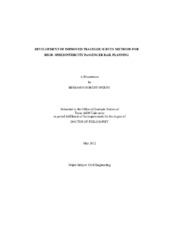| dc.contributor.advisor | Burris, Mark | |
| dc.creator | Sperry, Benjamin | |
| dc.date.accessioned | 2012-07-16T15:58:00Z | |
| dc.date.accessioned | 2012-07-16T20:28:16Z | |
| dc.date.available | 2014-09-16T07:28:20Z | |
| dc.date.created | 2012-05 | |
| dc.date.issued | 2012-07-16 | |
| dc.date.submitted | May 2012 | |
| dc.identifier.uri | https://hdl.handle.net/1969.1/ETD-TAMU-2012-05-10889 | |
| dc.description.abstract | High-speed passenger rail is seen by many in the U.S. transportation policy and planning communities as an ideal solution for fast, safe, and resource-efficient mobility in high-demand intercity corridors. To expand the body of knowledge for high-speed intercity passenger rail in the U.S., the overall goal of this dissertation was to better understand the demand for high-speed intercity passenger rail services in small- or medium-sized intermediate communities and improve planners' ability to estimate such demand through traveler surveys; specifically, the use of different experimental designs for stated preference questions and the use of images to describe hypothetical travel alternatives in traveler surveys. In pursuit of this goal, an Internet-based survey was distributed to residents of Waco and Temple, two communities located along the federally-designated South Central High-Speed Rail Corridor in Central Texas.
A total of 1,160 surveys were obtained from residents of the two communities. Mixed logit travel mode choice models developed from the survey data revealed valuable findings that can inform demand estimates and the design of traveler surveys for high-speed intercity passenger rail planning activities. Based on the analysis presented in this dissertation, ridership estimates for new high-speed intercity passenger rail lines that are planned to serve intermediate communities should not assume that residents of these communities have similar characteristics and values. The d-efficient stated preference experimental design was found to provide a mode choice model with a better fit and greater significance on key policy variables than the adaptive design and therefore is recommended for use in future surveys. Finally, it is recommended that surveys should consider the use of images of proposed train services to aid respondent decision-making for stated preference questions, but only if the images used in the survey depict equipment that could be realistically deployed in the corridor. | en |
| dc.format.mimetype | application/pdf | |
| dc.language.iso | en_US | |
| dc.subject | High-Speed Intercity Passenger Rail | en |
| dc.subject | Traveler Surveys | en |
| dc.subject | South Central High-Speed Rail Corridor | en |
| dc.subject | Stated Preference Surveys | en |
| dc.title | Development of Improved Traveler Survey Methods for High-Speed Intercity Passenger Rail Planning | en |
| dc.type | Thesis | en |
| thesis.degree.department | Civil Engineering | en |
| thesis.degree.discipline | Civil Engineering | en |
| thesis.degree.grantor | Texas A&M University | en |
| thesis.degree.name | Doctor of Philosophy | en |
| thesis.degree.level | Doctoral | en |
| dc.contributor.committeeMember | Quadrifoglio, Luca | |
| dc.contributor.committeeMember | Spiegelman, Cliff | |
| dc.contributor.committeeMember | Woosnam, Kyle | |
| dc.type.genre | thesis | en |
| dc.type.material | text | en |
| local.embargo.terms | 2014-07-16 | |


